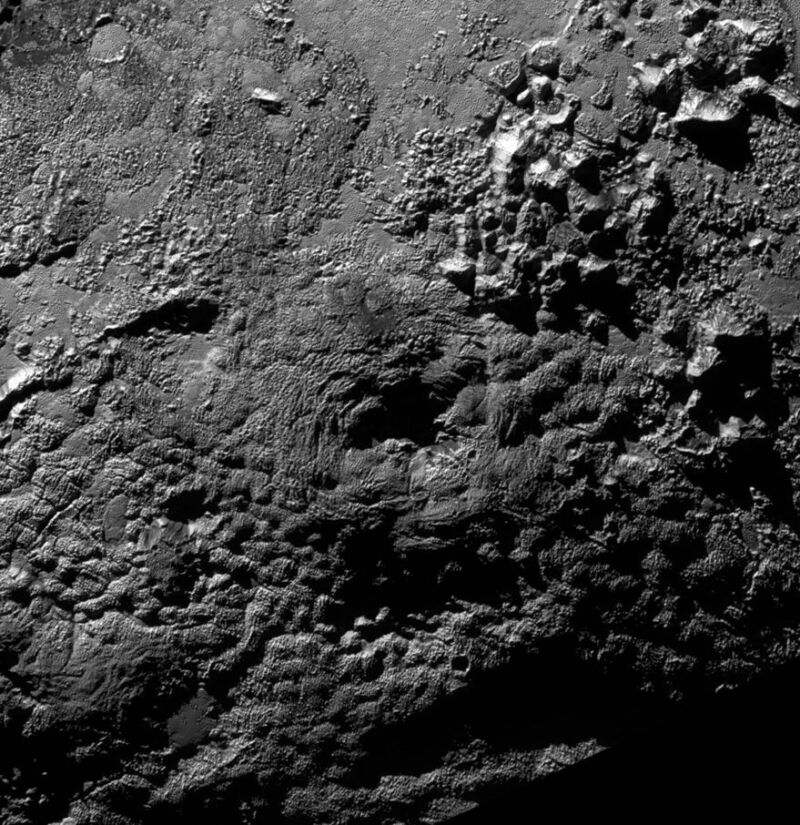When we look at the features on other bodies in our Solar System, there are often obvious analogs much closer to home. For example, sets of parallel ridges on Pluto appear to be the equivalent of snow features we call penitentes here on Earth. After all, a lot of geology is the product of physics, and if the same physics apply elsewhere, you can expect similar features.
But there are many times when the same physics don't apply, and that can leave scientists scratching their heads. One of those cases was described last week when researchers found that all the easy explanations for why some features have formed on Pluto don't actually work that well.
Cool story, bro
The feature in question is called Wright Mons, a bit of elevated terrain named after the Wright Brothers. There's a similar feature nearby called Piccard Mons, and when the features were first seen in photographs sent back from New Horizons, scientists described them as cryovolcanoes. In terms of their shape, both looked a lot like volcanoes on Earth, with an elevated peak and a crater-like feature in the center.
The surface of Pluto is mostly made of ice, as are both Wright and Piccard Mons, so researchers have expected that the features were made from semi-liquid ices that were forced to Pluto's surface. Hence, cryovolcanoes. They've been spotted on other cold bodies with minimal atmospheres, like Ceres, so why not Pluto?
The new paper takes a more careful look at the region around Wright Mons and finds that the story is probably not quite that simple. Cryovolcanism still appears to be to blame, but these features may not be direct analogs of volcanoes. And it's not at all clear where the energy to drive the volcanism could come from.
That doesn’t look right
A more careful look at Wright and Piccard Mons suggested that the volcano analogy falls a bit short. For starters, the craters were very large relative to the peaks, so if the crater formed through the collapse of a peak, the missing material would be roughly half the total volume that the peak once occupied. And there aren't the usual features associated with a collapse into a crater.
Part of that volume comes because the craters seem to be very deep, reaching back down to roughly the base of the volcano. Put differently, the bottom of the crater appears to be at the same elevation as the terrain that Wright Mons looms over. Again, that's very unusual for volcanoes.
An alternate explanation would be that these are impact craters. But that doesn't make much sense, either. For one thing, the chance that impacts will hit both of the largest peaks in the area—and hit them dead center—seems extraordinarily remote. The other problem is that there are no impact craters visible in this region at all.
"The geologic features in the Wright Mons region are morphologically unlike any other regions on Pluto," the researchers conclude, and they "have very few similarities to most terrains on other bodies in the Solar System."
The authors' best suggestion for an explanation comes from an examination of the terrain around the two peaks, which is extremely lumpy and covered with features called "hummocks." This is also true of the peaks themselves, as their flanks look as though they're covered in hummocks as well. So the researchers suggest that the two "volcanoes" are actually just cases of multiple hummocks merging in a pattern that happened to be circular, creating the appearance of a volcano.
How do you make a hummock?
The only problem with this explanation is that it's not clear how you can fill a terrain with this sort of lumpiness. The researchers still think that cryovolcanism is a good explanation since a viscous liquid or partially molten solid could spread slowly and form this sort of lumpy terrain.
The problem is that the materials present in the region don't really make sense in terms of the formation of this terrain. Nitrogen ice doesn't seem to be plentiful in the region, and that material is soft enough that it would tend to slowly flow back down under the pull of gravity, erasing this sort of terrain. There's not a lot of methane in the area, either.
What's left is mostly water, and that's a problem because water's melting temperature is well above the sorts of temperatures that the surface of Pluto reaches. Any liquid water left in Pluto's interior is thought to exist near the dwarf planet's core and is unlikely to power cryovolcanism near its surface. While the liquid water might have been more extensive in the distant past, the lack of any visible craters in the region means this terrain has been remodeled relatively recently.
So we're left with something that looks a lot like cryovolcanism, but the known mechanisms that drive their formation don't seem to be in operation elsewhere in our Solar System. The end result looks different from anything else we've seen before.
Nature Communication, 2022. DOI: 10.1038/s41467-022-29056-3 (About DOIs).



3175x175(CURRENT).thumb.jpg.b05acc060982b36f5891ba728e6d953c.jpg)

Recommended Comments
There are no comments to display.
Join the conversation
You can post now and register later. If you have an account, sign in now to post with your account.
Note: Your post will require moderator approval before it will be visible.